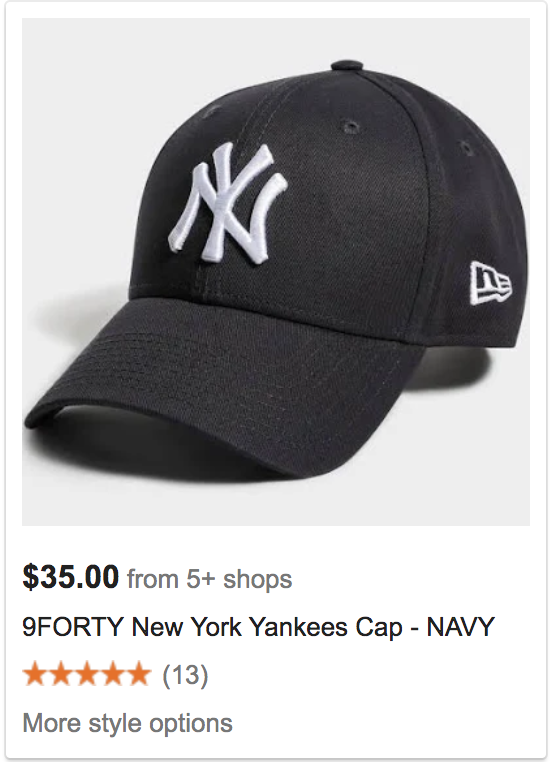So, you’ve decided to take your first step into the world of paid search.
First off, congratulations on making a smart choice for your business. Paid search offers companies incredible power, allowing them to jump straight in front of the people most vital to their business. It has the potential to help you forge instant connections with new customers and build stronger relationships with existing ones, letting you get the word out about your brand and your products faster.
But with so many options on the market, how do you know which type of ads to invest in? Unfortunately, there’s no single best way to do paid search, with each type of ad offering a different kind of advantage to your business and your brand.
Let Impress!ve™ be your guide to the world of paid search. Read on and let us show you how the different Google ad channels can help you get a leg up on the competition.

SHOPPING – TURNING CLICKS INTO CONVERSIONS
Modern eCommerce runs on Google Ads, but it’s Google Shopping – technically a separate service altogether – that is the true bread and butter for any eCommerce site owner. Shopping is an essential part of any campaign, to the point that for clients with a limited budget, we would prioritize Shopping above other channels.
Why? Because of its incredible potential for conversions. Let’s get one thing straight from the start – Google Shopping is not an awareness tool. By its very nature, it’s most effective at the bottom of the funnel – when a customer has done their research, has compared their options, knows what they want, and has begun to look for it. Its greatest strength as a BOFU (bottom of the sales funnel) tool is its greatest weakness as a TOFU (top of the funnel) tool – it takes a deep and narrow approach that allows clients to drill down to find exactly what they’re looking for. While this is ideal for moving clients those last few nudges towards a purchase – giving it an extremely high average ROI – it makes it extremely hard to spread awareness.
Succeeding at Google Shopping requires you to have a detailed knowledge of how to build a product feed. A feed is a file that provides Google with information about the product you are trying to sell. Getting this right is the heart of marketing via Google Shopping. There are very few ways to otherwise direct traffic – the feed provides everything Google Shopping needs to determine when and where to display your products.
Each product covered in a feed will ideally have four pieces of data attached – a title, a description, a link to the product page on your website, and a link to an image of the product.

Impressive’s Head of Paid Search Luis Campos noted that the small number of influenceable elements means that minor changes can have an outsized impact on the success of your campaign.
“The things that you can actually optimize – the choices you make that get your results – are always going to be limited by the product feed,” he said. “You have to work with that feed to make the campaign a success.”
A clear knowledge of what the algorithm is looking for versus what your customers are looking for is key.
“Imagine you’re selling a bottle of shampoo, and your product picture is an image of a woman holding a bottle of shampoo,” Luis said.
“While this might look fantastic on your website and help move products, on a Google Shopping page displayed on a mobile, all the customer will see is the woman’s face because the displayed image is very small. It’s small things like this that can affect your sales.”
The solution is working with someone who understands how to wrangle this very unique beast.
“Arguably the biggest benefit of working with an agency is that we know what works best with the product feed on any given day,“ Luis said.

SEARCH – THE ANSWERS YOUR CUSTOMER NEEDS
If Shopping is where you reel people in, Search is where you start casting your line. An exceptional middle-of-funnel (MOFU) tool, getting your brand on the search results page helps you meet customers when they’re beginning to look for someone like you.
It’s here that customers have realized they have a problem and are in the process of building a solution. Within this part of the funnel there are many considerations – so many in fact that some marketers build it out as a funnel of its own – but in a nutshell, to be effective at the research phase you need to be showing that you’re aware of the customer’s problem, you can solve the problem, and the solution is in your product.
While Shopping offers the highest ROI, it relies on a lot of work being done to that point to be truly effective. You need to have already made yourself the answer to each one of those questions before a customer is going to be willing to look at your products in the kind of detail only Google Shopping can provide.
It’s all because of the principle of effective frequency – basically, the minimum number of times a person must be exposed to an advertising message before they act. This number isn’t driven solely by Google Ads or even digital marketing as a whole – everything from your product in a shop window to a flyer to billboard aids in brand recall. If you’re a small business, a new business, or a niche business, likely, your average potential customer won’t have the level of exposure to your brand required to make them convert.
Senior SEM Lead Arnold Djapri said that because of this unless you’re a household name, almost every small to medium-sized business needs to be doing awareness. ‘
“Unless you’re a Nike, no one’s going to click on your business out of nowhere and convert immediately, it just doesn’t work that way for small to medium-sized businesses in competitive industries,” he said.
He was keen to note that even the largest, most well-known businesses still had a need for awareness, as there’s no such thing as a brand with 100% market penetration.
“Regardless of the size of the client, you still need to be bringing in new business,” he said. “Even if it’s no longer the main focus, you still need to be considering it as part of an integrated campaign.”
Search is exceptional at doing this kind of foundational work, intervening in a potential customer’s quest for a solution when they’re looking the hardest for answers. A correctly targeted campaign can ensure that your business thoroughly understands their needs and can provide them with exactly what they require.

Display – flexible & accessible
The Google Display Network is an incredibly versatile tool that lends itself extremely well to activities at a range of stages in the funnel.
Fundamentally, there are two broad strategies that rely on Display – retargeting and brand awareness.
Brand awareness is the most self-explanatory of the two – the omnipresence of Display ads and their extreme versatility allows businesses to hit a very broad target very quickly. Businesses can simply create a few basic ads introducing their brand and their core products, serve them across all audiences and start driving traffic to their website.
But what about social media? Can’t you just do all of your awareness-raising through that? While Facebook, Twitter, Instagram, and the rest of ‘em offer a wealth of tools for paid and organic awareness raising, they’re not the last word in it. Our Head of Paid Search Luis was careful to note that often a social awareness campaign and a Display awareness campaign can hit two very different groups of people.
“Social media has a whole different user base compared to Google and depending on your industry, your customers may be located elsewhere,” he said. “Social awareness campaigns are great for fashion and other industries that live and die on Facebook and Instagram, but if you’re selling something like tires, you’re not going to hit the right audience on social media.”
Additionally, it can be difficult to measure success for an awareness campaign whether it’s run on social or Display. Where the latter unambiguously shines and where the value is easiest to measure is when it’s used for remarketing.
These strategies can be as simple as serving a generic banner ad for a website a user has already visited, to more complex implementations relying on knowledge of what products the customer has looked at or abandoned in their cart.
However you choose to use it, Display has the potential to radically change the way you speak to your audience, helping to make you the first choice in your industry.
An integrated approach
Building a paid search campaign is not just a case of either/or, but a careful process of finding the right mix of components to suit your needs, your goals, and your budget. Every business at every stage of its growth can benefit from all ad types simultaneously because there’s no such thing as a company that’s too well-known or makes it too easy for existing customers to buy products.
We know this from our own experience. We’ve worked with both incredibly popular and brand new businesses in the same industry, and in both cases, we recognize the value of an integrated approach. Even for household names where customers are directly searching for the brand and the majority of the results are coming from Google Shopping, there’s always a need to keep an awareness campaign running to account for your newest fans.
If you’d like to find out how an omnichannel approach to paid search could grow your brand and your bottom line simultaneously, talk to the strategists at Impress!ve™ today.


